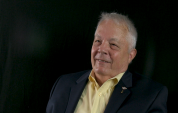4:21 | Bob Stewart was walking on air. He just got a call from NASA that he was accepted as a mission specialist on the space shuttle program. He was going to be an astronaut, but first he had one more flight in his capacity as an Army test pilot.
Keywords : Robert L. Bob Stewart National Aeronautics and Space Administration (NASA) George Abbey Hughes AH-64 Apache Robert Stewart

After an Opie from Mayberry upbringing, Bob Stewart came out of ROTC to get an Army commission. He was already a pilot, so he had his eye on becoming one in the largest air force in the world.
Helicopters? Bob Stewart felt they were beneath his dignity because, after all, he was an airplane pilot. What he found out at Fort Wolters is that the helicopter is the most difficult aircraft to fly, and the most versatile. Then it was on to the second phase at Fort Rucker where he was introduced to the Huey.
He was all choked up, thinking of his wife and daughter on the trip to Vietnam. Bob Stewart was fighting the loneliness until he received his assignment and got to the airfield at Soc Trang. He was slotted to fly armed helicopters, but was disappointed when he was told he had to start out in slicks, which are transport ships.
The gunship pilot didn't just provide supporting fire, he had to scout out the landing zones ahead of an assault. Bob Stewart was shot through the foot during one of these assaults. He took a break from missions, but continued his other job, giving check rides to new pilots.
The Christmas truces were a farce. Helicopter pilot Bob Stewart drew more fire during the holiday than usual. He flew down in the delta, supporting ARVN infantry. They had three divisions there, two of which were useless.
The first time he killed a man, he felt sick. After a few more, helicopter pilot Bob Stewart just felt glad he was the one who survived. Americans in Vietnam were often accused of just shooting up the place wildly, but that was not true, he says. There was one Buddhist province where he refused to fire, even if fired upon.
It was a ragtag army, fighting the world's largest superpower, on their land for their land. Helicopter pilot Bob Stewart had to put aside those observations because he had a job to do. Besides, the Viet Cong were brutal.
Helicopter pilot Bob Stewart pays tribute to the Dustoff pilots, who flew the Medevac flights. He felt emboldened in his combat flying because he knew they were there to get him out if something happened.
Helicopter pilot Bob Stewart remembers an incident in Vietnam when his battalion commander called in his platoon commander and demanded he do something about a crew chief who was smoking marijuana. The answer surprised him.
You got the lesser USO shows down in the Delta. Instead of Bob Hope and show girls, you got Martha Raye. Bob Stewart was a little disappointed with the lineup but the lady surprised him the next day when she helped treat the wounded.
He had stopped flying combat missions as his time to leave Vietnam neared, but Bob Stewart still gave check rides to new pilots. It was on one such "safe" flight that he responded to an emergency medical evacuation and wound up in combat anyway. When he landed in San Francisco a few days later, he felt uneasy, unarmed and surrounded by weird people.
Some of his pilot friends were recruited by the airlines but Bob Stewart had other ideas. He became a test pilot. They got the money but he had the fun. He was instrumental in bringing the Apache and Blackhawk helicopters into the Army's fleet of airships.
Somewhere along the line, Army test pilot Bob Stewart had filled out an application to NASA and they called him. He went to Houston for a week of testing and an interview as a mission specialist.
Bob Stewart arrived in Houston as the first active Army officer to become a space shuttle mission specialist. After a year of classes, he was given a technical task, develop the shuttle's entry flight control system. The first flight was scheduled for two years out but he had to give management some bad news.
Bob Stewart was more nervous going to Vietnam than he was going into space the first time. You could get maimed in combat but in space you were either A-OK or completely gone. He made two flights on the space shuttle and, along with Bruce McCandless, made the first EVA with the new MMU, the Manned Maneuvering Unit.
After the Challenger tragedy, NASA mission specialist Bob Stewart returned to the Army where they made him a general. He worked at the Strategic Defense Command, a legacy of Ronald Reagan's SDI program. At some point the Army wanted him in Washington DC, at which point he promoted himself to ski bum.